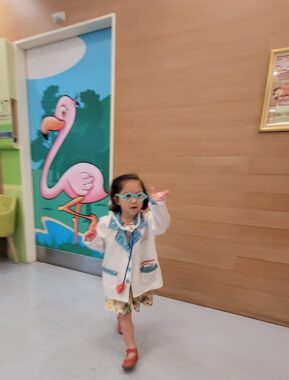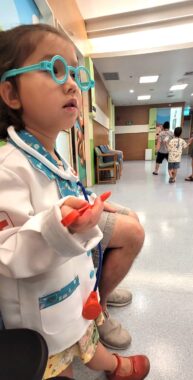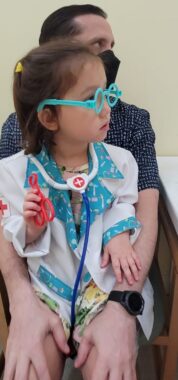How we’ve helped our daughter work through her medical anxiety
Celebrating our first 'no tears' doctor appointment

As soon as the car pulls up to the hospital, crying and ear-piercing screaming commence. My daughter arches her back and squeezes her eyes shut. It’s impossible to console her. We must resort to holding her down and forcing her to submit, which doesn’t help us with future visits.
Until recently, this was our family’s reality at every doctor and hospital appointment.
Our daughter, Rylae-Ann, was diagnosed with aromatic l-amino acid decarboxylase (AADC) deficiency. In addition to other life-threatening symptoms, increased anxiety is associated with AADC deficiency due to the lack of the AADC enzyme. This means that the necessary neurotransmitters dopamine and serotonin are severely affected.
Even after gene therapy, our daughter still experienced high anxiety. In our opinion, this was related more to pediatric medical traumatic stress, since gene therapy has allowed her to make wonderful progress in regards to all the other symptoms of AADC deficiency. We avoided the hospital as best we could and continued with telehealth appointments, but sometimes you just have to physically go to the doctor.
Drama therapy
Our strategy began with talking to our daughter and trying our best to explain everything that would happen. Part of the anxiety she experienced stemmed from the unknown and uncertainty. Talking about what was coming helped her make some progress. However, in my experience as a father and teacher, I’ve found that children learn best from play.
Drama therapy is a type of expressive or creative therapy. This category also includes music therapy, which we continue to incorporate or switch between to create novelty. In drama therapy, the patient and sometimes even the teacher express themselves through role-playing. It offers a safe way to act out scenarios and provide in-the-moment feedback, and it can be easily accomplished during stressful events. A major benefit of this therapy is the ability to concentrate on emotions and express feelings.

Rylae-Ann confidently enters the children’s ward. (Photo by Richard E. Poulin III)
Role-playing the hospital visit
This is not a one-time session. It’s a progression that leads to improvement over time. Even though we didn’t see immediate results with Rylae-Ann, significant learning was still happening. In addition, we’d incorporate other therapy goals to help maximize each session.
We bought a white lab coat and a complete children’s doctor kit for our daughter. Before starting a session, it was important for Rylae-Ann to get used to the toys and find joy in them. We used the tuning-in stage to talk about the names of each medical tool, and operating them enabled us to work on fine motor skills. The entire time we maintained a play-based approach to learning.

Although somewhat apprehensive, Rylae-Ann patiently waits outside the doctor’s office wearing her doctor costume. (Courtesy of Richard E. Poulin III)
Results of drama therapy
Recently, Rylae-Ann had a completely different hospital experience. Although she was noticeably anxious at times and on the verge of tears, she managed her emotions well.
Our daughter went to the hospital wearing her white lab coat and carrying her doctor’s kit. It helped that the nurses and doctors took part in the role-playing. She entered the hospital with confidence. She entered the children’s ward slowly, but she complied with all the routine checks. She was excited to show off her tools.
Then came the big step: entering the doctor’s office. It’s much smaller and has more serious-looking equipment. It took some coaxing, but she went in and sat with me. She allowed the doctor to do his tests, and the visit was very efficient. It went so well that we scheduled a follow-up appointment to complete some overdue blood tests. Again, everything went well. She didn’t cry until she saw blood going into the vial. Once she had her pink Band-Aid on, her tears were dry.
Other parents waiting in the children’s ward commented on what a good idea role-playing was and that they’d do something similar next time. This type of therapy can benefit all children and make a challenging experience a bit more enjoyable. It also demonstrates how simple ideas can lead to big changes. It’s not difficult. It just requires patience, a little bit of creativity, and a miniature lab coat.

Rylae-Ann sits with her dad, without tears, during a consultation with a doctor. (Courtesy of Richard E. Poulin III)
Note: AADC News is strictly a news and information website about the disease. It does not provide medical advice, diagnosis, or treatment. This content is not intended to be a substitute for professional medical advice, diagnosis, or treatment. Always seek the advice of your physician or other qualified health provider with any questions you may have regarding a medical condition. Never disregard professional medical advice or delay in seeking it because of something you have read on this website. The opinions expressed in this column are not those of AADC News or its parent company, BioNews, and are intended to spark discussion about issues pertaining to aromatic l-amino acid decarboxylase deficiency.






Comments